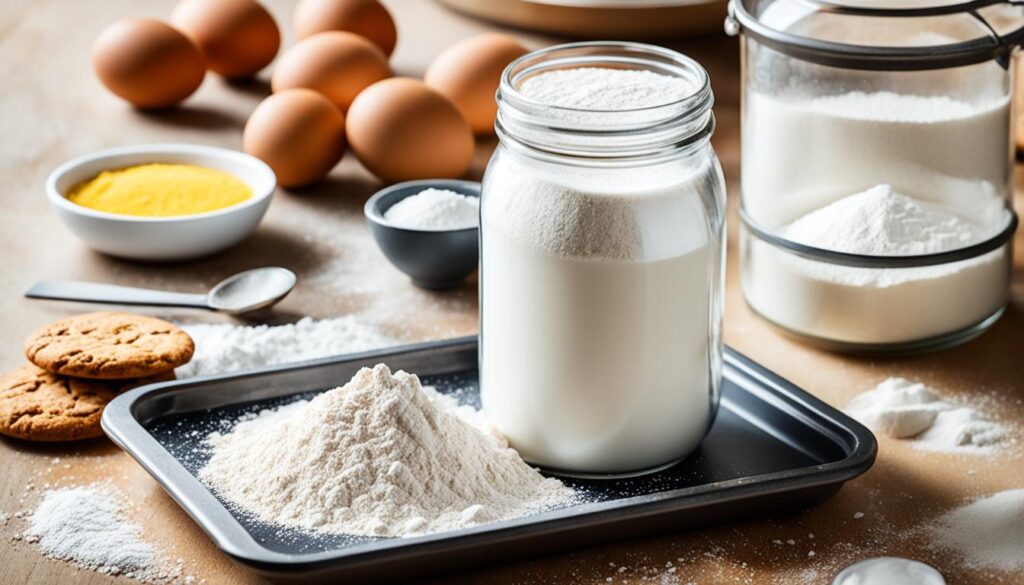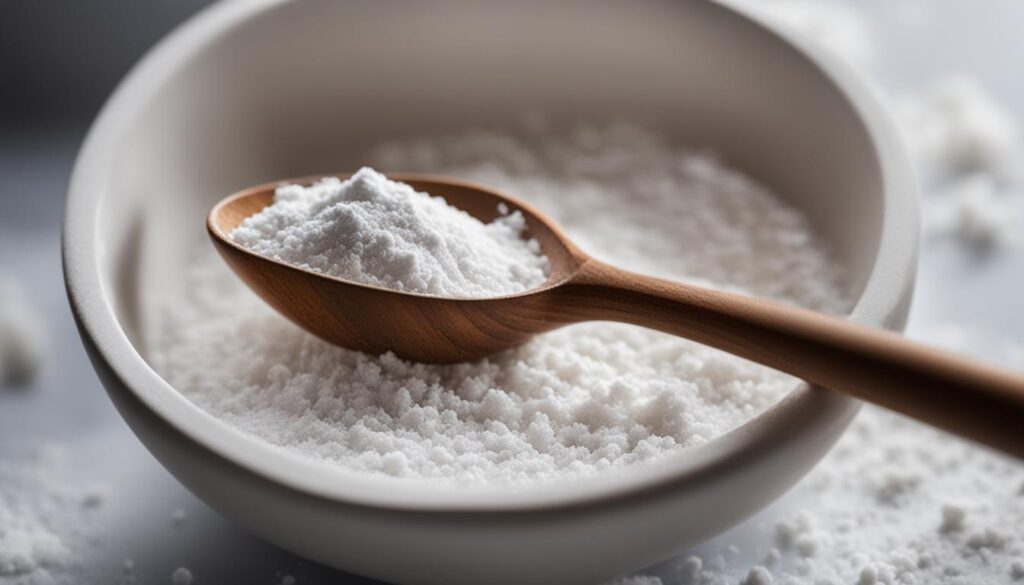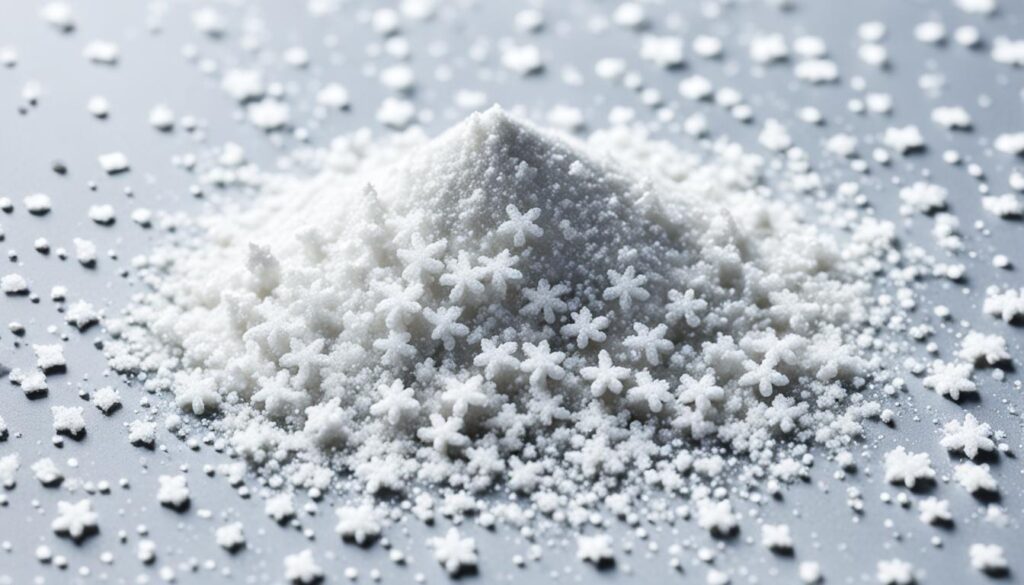Did you know that you can make your own baking soda right in your own kitchen? Baking soda, also known as sodium bicarbonate, is a versatile ingredient with a wide range of household uses. Instead of buying it from the store, you can easily create your own baking soda using simple ingredients. In this article, I will guide you through the process of making baking soda at home, allowing you to save money and have control over the quality of your product.
Key Takeaways:
- Learn how to make your own baking soda from sodium bicarbonate.
- Save money by producing baking soda at home.
- Have control over the quality of your homemade baking soda.
- Understand the different uses of sodium bicarbonate.
- Discover the process of making a baking powder substitute.
What is Baking Soda and Baking Powder?
Baking soda and baking powder are both essential ingredients in baking, serving as raising agents that help baked goods rise and become light and fluffy. Let’s take a closer look at each of these ingredients and understand their unique properties.
Baking soda is also known as sodium bicarbonate. It is a pure form of the compound and acts as a powerful leavening agent when combined with an acidic ingredient. When baking soda reacts with moisture and an acid, such as cream of tartar, it produces carbon dioxide gas. This gas causes the dough or batter to expand, resulting in a rise in the final product.
Baking powder is a mixture of sodium bicarbonate and an acid, often including cream of tartar, but it may also contain other acidic components. The acid within the baking powder activates the leavening power of the sodium bicarbonate when mixed with liquid. Unlike baking soda, baking powder contains its own acid, so it can be used on its own without the need for additional acidic ingredients.
Both baking soda and baking powder release carbon dioxide gas when exposed to moisture, but it’s important to note that they have different applications in recipes. Baking soda requires an acidic ingredient to activate its leavening properties, while baking powder can be used in recipes that do not include additional acid.
Baking soda and baking powder are often used in combination in recipes to achieve optimal rising and leavening effects. The precise measurement and balance of these ingredients are crucial to ensure the desired texture and consistency in baked goods.

In summary, baking soda and baking powder are indispensable ingredients in the world of baking. Understanding their functions and knowing when to use each one will empower you to create delicious and perfectly risen baked treats.
How to Make Baking Powder Substitute
If you run out of baking powder while baking, don’t worry! You can easily make a substitute using common ingredients found in your pantry. By combining baking soda with cream of tartar, you can create a homemade baking powder substitute that works just as well in your recipes.
Baking Soda: Baking soda, also known as sodium bicarbonate, is a versatile ingredient commonly used in baking. It reacts with acidic ingredients to release carbon dioxide gas, causing dough or batter to rise.
Cream of Tartar: Cream of tartar is a powdery substance derived from winemaking. It is an acid and provides the necessary acidic reaction when combined with baking soda. You can easily find cream of tartar in most grocery stores.
To make the baking powder substitute, simply mix together:
| Baking Soda | Cream of Tartar |
|---|---|
| 1 tablespoon | 2 tablespoons |
This homemade baking powder substitute can be used as a replacement for commercial baking powder in a 1:1 ratio. However, it’s important to note that this substitute does not have the same double-acting properties as store-bought baking powder.
Now, you’re ready to continue baking without any interruptions. Enjoy your homemade baking powder substitute!

How to Make Baking Soda from Sodium Bicarbonate
Did you know that you can transform baking soda into a stronger alkaline salt called sodium carbonate? This is helpful for specific applications, such as making ramen noodles. To make sodium carbonate, place baking soda in a hot oven at 350°F (175°C) for 2 to 5 hours, stirring it every half hour. The baking soda will gradually transform into sodium carbonate, which can be used as a substitute for baking soda in recipes that require a stronger alkaline salt.

Step-by-Step Guide:
- Preheat your oven to 350°F (175°C).
- Spread 1 cup of baking soda evenly on a baking sheet.
- Place the baking sheet in the oven and bake for 2 to 5 hours, stirring the baking soda every half hour to ensure even heating.
- Remove the baking sheet from the oven and let the baking soda cool completely.
- Store the sodium carbonate in an airtight container for future use in recipes that require a stronger alkaline salt.
With this simple process, you can easily make your own sodium carbonate, a powerful alkaline salt, from baking soda. Enjoy experimenting with this homemade substitute in your favorite recipes, like ramen noodles or other dishes that require a stronger alkaline ingredient.
Storage and Shelf Life of Homemade Baking Soda
After making your homemade baking soda, it is important to store it properly to maintain its quality and potency. Transfer the baked baking soda into an airtight container to prevent moisture from getting in. Ensuring airtight storage is crucial for preserving the freshness and effectiveness of your homemade baking soda.
It’s important to note that baked baking soda is a caustic substance, so it is essential to avoid direct contact with your skin. Take necessary precautions to protect yourself by wearing gloves and handling it with care.
In an airtight container, homemade baking soda can be stored indefinitely, thanks to its exceptional stability. However, to ensure optimal freshness, it is advisable to use it within one month. This way, you can always rely on the best results when using your homemade baking soda in your favorite recipes.
To check the potency of your homemade baking soda, consider conducting a fizz test before incorporating it into your recipes. This quick and simple test will confirm if your homemade baking soda is still reactive and suitable for use.
FAQ
How can I make my own baking soda at home?
To make your own baking soda, you can place baking soda in a hot oven at 350°F (175°C) for 2 to 5 hours. Stir it every half hour to ensure even baking. After this process, the baking soda will transform into sodium carbonate.
What is the difference between baking soda and baking powder?
Baking soda is a pure form of sodium bicarbonate, while baking powder is a mixture of sodium bicarbonate and an acid. Baking soda needs an acidic ingredient in a recipe to activate it, while baking powder can be used on its own.
Can I make a substitute for baking powder using baking soda?
Yes, you can make a substitute for baking powder using baking soda and cream of tartar. Mix together 1 tablespoon of baking soda and 2 tablespoons of cream of tartar to create the substitute.
How can I store homemade baking soda?
After making homemade baking soda, transfer it to an airtight container to prevent moisture from getting in. It’s important to note that baked baking soda should be stored properly as it is a caustic substance. Homemade baking soda can be stored indefinitely, but it’s best to use it within one month for optimal freshness.
How can I make a baking powder substitute for my recipes?
You can make a baking powder substitute by mixing 1 tablespoon of baking soda with 2 tablespoons of cream of tartar. This homemade substitute can be used in a 1:1 ratio as a replacement for commercial baking powder in recipes.






